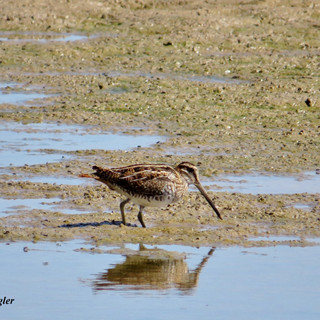This is my first post on what I call "piedmont mudflat shorebirding." The idea is this: every year in late summer to early fall, the water level in Jordan Lake drops, exposing mudflats at the shallow northern ends of the lake. The emergence of mudflats coincides with the post-breeding dispersion of wading birds, as well as the southward migration of shorebirds; the result being that the piedmont attracts species that are more typically associated with coastal locations. Waders and shorebirds are some of my favorite families of birds, so I really enjoy birding this time of year. In my mind, late-summer shorebirding is much more exciting than the later fall passerine migration.

In 2015, The lake steadily dropped beginning in mid-July until it bottomed out at a near-record-low 212.5 feet (4 feet lower than normal) near the end of September. Extensive mudflats were present from mid/late August through September, providing extensive habitat for shorebirds migrating south during this period. I quickly realized that I should invest in a tripod and spotting scope, and once I did, I got my money’s worth. In contrast to later years (with birding dominated by kayak), I did most of this birding by hiking in with my new spotting scope.
Having only taken up birding beyond-the-backyard in December 2014, the fall of 2015 was my first attempt ever at identifying shorebirds, which can be very challenging for the uninitiated. Thankfully, I had the help of some local experts and ideal conditions for this first foray into piedmont mudflat shorebirding. Most of the birds noted below were found by other birders, and I was lucky enough to see them after learning of their whereabouts.
Overall, it was very productive for my first year doing this, with 13 species of shorebirds (highlights included an American Golden Plover, 3 Sanderling, 21 Stilt Sandpiper, and a Wilson’s Snipe) and 5 species of waders (best being a Snowy Egret, 4 immature Little Blue Heron, and 9 immature White Ibis).
Summary:
8 trips to the lake from late August through September. I visited the New Hope Creek mudflats 3 times in late August; the Morgan Creek mudflats twice in mid-September (once by kayak); and the Northeast Creek (Hwy 751) mudflats 3 times in late-September. (Also a trip to the Ellerbe Creek mudflats on Falls Lake, but I won’t count that here, except to note that there were 3 Buff-breasted Sandpipers).
13 species of shorebirds and 5 waders
Lake dropping to 212.5 through September
Species lists (1st number: number of occasions seen; 2nd number: max number of individuals): Shorebirds:
American Golden Plover 3/ 1
Semipalmated Plover 4/ 12
Killdeer 7/ 28
Stilt Sandpiper 1/ 12
Sanderling 2/ 2
Least Sandpiper 2/ 50
Pectoral Sandpiper 4/ 30
Semipalmated Sandpiper 1/ 1
Wilson’s Snipe 1/ 1
Spotted Sandpiper 2/ 2
Solitary Sandpiper 2/ 2
Greater Yellowlegs 2/ 2
Lesser Yellowlegs 8/ 30
Waders:
Great Blue Heron 8/ 15
Great Egret 8/ 85
Snowy Egret 1/ 1
Little Blue Heron 3/ 4
White Ibis 2/ 8
Ducks/geese:
Canada Goose 2/ 80
Blue-Winged Teal 3/ 15
Northern Shoveler 2/ 2
Mallard: 1/ 75












